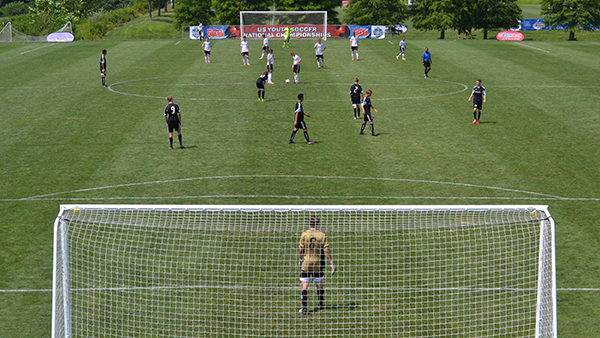O’Sullivan: Some thoughts on U.S. Soccer’s mandatory changes in youth soccer

The U.S. Soccer Federation recently announced sweeping changes in the way that youth soccer will be organized and run in this country, and it has caused quite the debate.
Many pundits believe this is the panacea that is needed to take our men’s international players to the next level. Others think this spells the doom of the game in our country.
The federation has asked all its members to get on board with the changes, support them, educate their members and help with the transition. I think unity in player development in this country is long overdue, and a great thing.
+READ: O’Sullivan: 3 myths that are destroying the youth sports experience
But I do wonder: Are we being asked to get behind an initiative that may gut our player numbers at the same exact time we are finally creating an environment that will allow those players to flourish?
Let’s take a look at the two most impactful new U.S. Soccer mandates, which are recommended for now and mandatory by August 2017. One is exactly what the doctor ordered; the other, I am not so sure.
Small-sided game mandate
The new small-sided game mandates are fantastic, and long overdue. Players become better by not only moving faster, but by thinking faster. Players also enjoy the game more when they get more touches, score more goals, and those who do not grow first but have great technique can still influence the game.
“Youth soccer in the US persisted in playing 11v11 far too young because state associations knew that if they mandated small-sided play, clubs could simply take their ball and leave.”
There is ample evidence of the benefits of small-sided games, whether it is simply to look at the South American futsal culture, top European academies’ focus on 9v9 until Under-12 to U-14 ages, or studies such as this one done at Manchester United about the increased frequency of goals, assists, passes, tackles and actions per game in smaller vs. bigger games.
In the Man United study, playing 4v4 instead of 8v8 yielded:
- 135% more passes
- 260% more Scoring Attempts
- 500% more Goals Scored
- 225% more 1v1 Encounters
- 280% more Dribbling Skills (tricks)
I have often wondered why U.S. Soccer did not take this simple and very effective action long ago. Watching undersized and under-strength 9-year-old kids unable to get out of their end playing 11v11 soccer should have been eliminated years ago. US Youth Soccer state associations have been tackling this on a state-by-state basis for almost two decades, but even today some states still allow 11v11 at U11.
 Sadly, youth soccer in the US persisted in playing 11v11 far too young because state associations knew that if they mandated small-sided play, clubs could simply take their ball and leave. When I was a club director in Oregon, for example, the state mandated small-sided games until U-12. Most clubs in Portland started their own 11v11 league through US Club Soccer, which was glad to take their money and let them run whatever kind of league they wanted.
Sadly, youth soccer in the US persisted in playing 11v11 far too young because state associations knew that if they mandated small-sided play, clubs could simply take their ball and leave. When I was a club director in Oregon, for example, the state mandated small-sided games until U-12. Most clubs in Portland started their own 11v11 league through US Club Soccer, which was glad to take their money and let them run whatever kind of league they wanted.
Colorado Youth Soccer recently feared the same, so for the past two years they sponsored both a 9v9 and 11v11 league for U-11s. Both moves were not beneficial to soccer in their respective states.
Thankfully, U.S. Soccer has stepped in and mandated smaller field sizes, smaller player numbers, and more developmentally appropriate rules such as “build-out lines” to encourage play from the back, and discouragement of goalkeeper punts. This has made the decision an easy one for all USSF affiliates, and is a home run for youth soccer in the U.S.
Watching my 9-year-old daughter play this weekend with these rules in place was so much better than watching a diminutive goalkeeper last year trying to take a goal kick with a 17-player wall on the top of the penalty area, and the referee constantly restarting the play because she could not kick it out of the box.
+READ: O’Sullivan: The early specialization dilemma in North American soccer
What I do hope happens next is some flexibility and creative thinking, though. Just because it says a U-11 should be playing 9v9 does not mean every U-11 needs to be. I think this is especially relevant with kids on the lower end of the playing spectrum physically and technically. Keep them playing 7v7 with more touches on smaller spaces!
Also, just because the roster says “maximum of 14 players” does not mean you need to fill it! Last year I watched my U-9 daughter and U-8 son playing simultaneous games. The U-8s were playing 5v5, and their roster of 12 was playing two games side by side (two subs total and 200 percent more touches). The U9 girls were playing 8v8, and their six subs sat idly on the sideline awaiting their turn to play.
How much better would it be to have 18 kids on a roster and play two 7v7 games side by side? Your best coach could now train 18 instead of 14 players, and you could have the flexibility of playing an A and B group, mixed group, even moving players around.
Overall, though, this is a hugely positive move by U.S. Soccer, and they deserve an A+ for it!
Calendar-year age groups
The most controversial mandate by U.S. Soccer is the change to birth-year age groups, as opposed to the August 1 through July 31 age groups we currently use. The latter groups were introduced to more closely align with school cutoffs, allowing children to play with their classmates, and have contributed greatly to the growth of the game at the U-12 and under levels (kids want to have fun and play with their friends, according to research).
 US Soccer is changing registration to calendar year to align with the rest of the world. In the words of USSF Youth Technical Director Tab Ramos, “It makes the process easier. Over the years you go through coaching youth soccer and you are constantly finding parents and players confused about what age group players belong in … It also puts our players on the same age-playing calendar as the rest of the world so they will be used to competing in the right age-group. That makes it much easier for us to scout for the national teams and find players ready to compete internationally.”
US Soccer is changing registration to calendar year to align with the rest of the world. In the words of USSF Youth Technical Director Tab Ramos, “It makes the process easier. Over the years you go through coaching youth soccer and you are constantly finding parents and players confused about what age group players belong in … It also puts our players on the same age-playing calendar as the rest of the world so they will be used to competing in the right age-group. That makes it much easier for us to scout for the national teams and find players ready to compete internationally.”
The birth-year logic certainly makes a boatload of sense in the elite player realm, and from the ages of perhaps U-12 and older. Here we are starting to identify top players on state, regional and national levels, and having them grouped and playing all their soccer with those similar age groups makes perfect sense. Yet the new U.S. Soccer mandate sets these rules for all USSF affiliates down to U-6, which would include all recreational players in AYSO, SAY Soccer, US Club and US Youth Soccer, and this could potentially be a huge mistake.
The overwhelming majority of players in this country are not elite, despite what their team name or league name says. According to Tom Farrey of the Aspen Institute’s Project Play Initiative, nearly 20 percent of all U.S. 6-year-olds play soccer, but by age 12 that is down to 13 percent. As soon as we sign them up, we start losing them, and telling these kids that they cannot play with their classmates any more because they were born in different years seems counterproductive.
“We are not failing at the international level because we have an August 1 cutoff date…We are failing because we are not properly developing these players once we get them.”
Telling them they can “play up” against kids in a different grade makes no sense either. For example, my 8-year-old son is born in late May, meaning he would have to play against kids nearly 18 months older than himself to play with his classmates. This may make sense for some kids; it certainly does not serve the vast majority of children.
Youth soccer in the U.S. competes with so many sports for players. Every other youth sport in the U.S. will allow them to play with and against age-level classmates. What do we think many kids will do, play soccer with kids they don’t know, or play other sports with their friends?
Changing to birth-year at very young ages, I believe, will damage one thing that soccer has done very well in this country, which is to attract vast amounts of youth players. Other countries are envious of our player numbers, especially given all the other sports choices kids have. We are not failing at the international level because we have an August 1 cutoff date. We are not failing because hundreds of our top players have not been identified because we are unsure of their age. We are failing because we are not properly developing these players once we get them.
In order to develop the type of culture that will allow us to compete better internationally, we first need millions upon millions of soccer fans, lifelong players and future coaches. The youngest ages are first and foremost about instilling a LOVE OF THE GAME and intrinsic motivation to keep playing! We need to continue to reduce barriers to play, and make the focus on the needs of the kids at these very young ages. This means (1) having fun (2) playing with their friends (3) learning new things (4) having an exciting time.
To be clear, I completely agree with aligning elite U.S. player development with the rest of the world, at an age where identifying and funneling the top players into the best environment is more appropriate, and the player has some ownership and say in the decision. Until then, it seems counterproductive when it takes them away from their school friends.
+READ: Dure: U.S. Soccer’s birth-year plan is shortsighted, helping coaches, not kids
The argument made by U.S. Soccer – that this helps to combat the “relative age effect” by making organizers more informed – seems weak at best. There will still be a relative age effect; only it will positively affect players born in January through April, instead of August through November. The idea that organizers are unaware of this effect does not seem to be a compelling reason for such a drastic change, as the effect has been well documented and there are very few, if any, club directors I have met who are unaware of this.
Instead, why doesn’t U.S. Soccer use birth-year age groups as a defining line in player development? This could be a huge opportunity. They have been advocating for decades the need to improve the environment for players 12 and under, by taking the emphasis off winning and focusing on technical and tactical development. They are well aware of the overemphasis on results at the youngest ages. Isn’t this an opportunity to draw a line in the sand by essentially saying, “everything your team does prior to age 12 means nothing, because at age 12 we switch to birth years for top level players”?
 If we do this, at age 12, there is now a reason for players to move onto a more competitive team, travel more, and devote more time to their game, for the select few players ready to make this jump.
If we do this, at age 12, there is now a reason for players to move onto a more competitive team, travel more, and devote more time to their game, for the select few players ready to make this jump.
Isn’t this a perfect way to segregate the small amount of kids who are truly pursuing (and capable of pursuing) an elite path, and the vast majority of players that should not be traveling 1,000 miles to play a similar level of competition that exists down the road?
Again, I completely agree that birth-year segregation is the way to go for elite player development for the reasons U.S. Soccer outlines. But by requiring it for all ages, do we not risk alienating our player base? Do we not risk cutting the legs out from under ourselves by reducing the number of players in the game? Are we sacrificing one thing we do very well (attract millions of young players) simply to make it easier to identify the elite few 6-10 years down the line?
Did anyone actually ask any 6- to 10-year-olds who are still experimenting with numerous sports whether they will keep playing soccer if they can no longer play with their classmates? Did anyone ask them what they would do if given a choice between soccer with older/younger grade kids or another sport with classmates? I asked my two kids, and the results were not encouraging for this soccer dad (I have a December and a May birthday in my family).
This switch has all the hallmarks of being a contributing factor to declining sports enrollment: We no longer ask kids what they want. Of all the reasons given for making the small-sided games switch, every reason is child-centric. That’s why I give it an A+.
+READ: Resentment, conspiracy theories simmer as youth soccer bodies push birth-year change
Of all the reasons given for the birth-year switch from age 12 and down, not a single one that I read says anything about how this will make it better for the kids, only for the adult organizers! That’s why I think it is a big, fat F.
So, in conclusion, congrats to U.S. Soccer, and many kudos, for the small sided games mandate that will help grow the game, and make it a more child-friendly experience.
But as far as birth-year age organization goes, I hope U.S. Soccer will look very hard at its mandate, for they clearly state that their purpose is “to make soccer, in all its forms, a preeminent sport in the United States and to continue the development of soccer at all recreational and competitive levels.”
Cramming millions of players into a one-size-fits-all age grouping designed to specifically help in elite player identification does not seem to fit this mission.
How do you think these changes affect the beautiful game in this country? Let’s continue the debate.
SOCCERWIRE MARKETPLACE
- MANCHESTER CITY SOCCER CAMPS
- FC Bayern Soccer Camps - $30 PROMO CODE: BMSOCCERWIRE
- Real Colorado Cup 2026
- Join a College Coaches Showcase Camp Today
- MICFootball Punta Cana 2026
- Dana Cup Hjørring 2026
- 15th Annual Loudoun Soccer College Showcase
- OFFICIAL FC BARCELONA SOCCER CAMPS - PROMO CODE: FCBSOCCERWIRE
- New England Copa Surf 2026
- Adidas National Cup 2026












